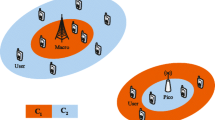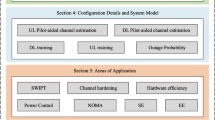Abstract
The performance of cellular networks is strongly limited by inter-cell interference. In order to reduce this interference, several techniques have been proposed, e.g., the frequency reuse techniques and distributed antenna system (DAS). This paper investigates the combinations of hard frequency reuse (HFR) and soft frequency reuse (SFR) techniques with DAS in a unique cell architecture, which are called DAS–HFR and DAS–SFR, respectively. This paper analytically quantifies the performance of the downlink multi-cell for DAS–HFR and DAS–SFR in terms of the average spectral efficiency. This also shows, the most appropriate frequency reuse technique depends not only on the average achievable data rate inside the cell, but also on the guaranteed achievable data rate (the minimum achievable data rate which is necessary to be obtained regardless of geographic location). The results show that DAS–SFR improves the achievable data rate of cell edges in a multi-cell environment as compared to a DAS–HFR when frequency reuse factor 1 is utilized. The results also show that DAS–SFR significantly increases the system capacity as compared to the DAS–HFR when frequency reuse factor 3 is utilized.












Similar content being viewed by others
Notes
\(\mu _{N}= \sum _{n \in {SoS}} \left[ {D_n^{(0)}} \right] ^{ - \delta }{P_n^{(0)}} \text {exp} \left( { {\lambda } \mu _n^{(0)} + \lambda ^2 \frac{ \left[ {\sigma _n^{(0)}} \right] ^2 }{2} }\right) \)
\(\sigma _{N}^2 =\sum _{n \in {SoS}} \left[ {D_n^{(0)}} \right] ^{ - 2\delta } \left[ {P_n^{(0)}} \right] ^2 \text {exp} \left( { {2 \lambda }{ \mu _n^{(0)}} + \lambda ^2 \left[ {\sigma _n^{(0)}} \right] ^2 }\right) \left( { \text {exp} \left( \lambda ^2 \left[ {\sigma _n^{(0)}} \right] ^2 \right) -1 }\right) \)
\(\mu _{D}= \sum _{i = 1}^{18} \sum _{n \in {SoS}} \left[ {D_n^{(i)}} \right] ^{ - \delta } {P_n^{(i)}} \text {exp} \left( { {\lambda } \mu _n^{(i)} + \lambda ^2 \frac{\left[ {\sigma _n^{(i)}} \right] ^2}{2} }\right) \)
\(\sigma _{D}^2 = \sum _{i = 1}^{18} \sum _{n \in {SoS}} \left[ {D_n^{(i)}} \right] ^{ - 2\delta } \left[ {P_n^{(i)}} \right] ^2 \text {exp} \left( { {2 \lambda } \mu _n^{(i)} + \lambda ^2 \left[ {\sigma _n^{(i)}} \right] ^2 }\right) \left( { \text {exp} \left( \lambda ^2 \left[ {\sigma _n^{(i)}} \right] ^2 \right) -1 }\right) \)
References
Giuliano, R., Monti, C., & Loreti, P. (2008). Wireless technologies advances for emergency and rural communications: WiMAX fractional frequency reuse for rural environments. IEEE Wireless Communications, 15(3), 60–65.
Dai, H., Molisch, A., & Poor, H. (2004). Downlink capacity of interference-limited MIMO systems with joint detection. IEEE Transaction on Wireless Communication, 3(2), 442–453.
Cao, Z., Tureli, U., & Yao, Y. D. (2007). low-complexity orthogonal spectral signal construction for generalized OFDMA uplink frequency synchronization. IEEE Transaction on Vehicular Technology, 56(3), 1143–1154.
Ozan, K. O., & El Gamal, H. (2011). Cooperative encoding for secrecy in interference channels. IEEE Transaction on Information Theory, 57(9), 5682–5694.
Love, D. J., Heath, R. W., Santipach, W., & Honig, M. L. (2004). What is the value of limited feedback for MIMO channels? IEEE Communications Magazine, 42(10), 54–59.
Hayssam, D., & Wei, Y. (2010). Coordinated beamforming for the multicell multi-antenna wireless system. IEEE Transaction on Wireless Communication, 9(5), 1748–1759.
Clark, M., Willis, T. III, Greenstein, L., Rustako, A. Jr., Erceg, V., Roman, R. (2001). Distributed versus centralized antenna arrays in broadband wireless networks. Vehicular Technology Conference, 53rd, vol. 1. IEEE (pp. 33–37).
Saleh, A. A. M., Rustako, A. J., & Roman, R. S. (1987). Distributed antennas for indoor radio communications. IEEE Transaction on Communication, 35, 1245–1251.
Andrews, J., Choi, W., & Heath, R, Jr. (2007). Overcoming interference in spatial multiplexing MIMO cellular networks. IEEE Wireless Communication, 14(6), 95–104.
Choi, W., & Andrews, J. (2007). Downlink performance and capacity of distributed antenna system in multi-cell environment. IEEE Transaction on Wireless Communication, 6(1), 1676–1680.
David Gonzalez, G., Garcia-Lozano, M., Ruiz Boque, S., & Seop Lee, D. (2013). Optimization of soft frequency reuse for irregular LTE macrocellular networks. IEEE Transaction on Wireless Communication, 12(5), 2410–2423.
Jiming, C., Peng, W., & Jie, Z. (2013). Adaptive soft frequency reuse scheme for in-building dense femtocell networks. Communications, China, 10(1), 44–55.
Huawei. (2005) Soft frequency reuse scheme for UTRAN LTE. 3GPP, Huawei R1–050507, May (2005).
Wang, Z., & Stirling-Gallacher, R. A. (2002). Frequency reuse scheme for cellular OFDM systems. Electronics Letters, 38(8), 387–388.
Huiling, Z. (2012). On frequency reuse in cooperative distributed antenna systems. Communications Magazine, IEEE no. 4, (pp. 85–89).
Zhang, R., & Li, G. (2013). Distributed antenna systems in fractional-frequency-reuse-aided cellular networks. IEEE Transaction Vehicular Technology, 62, 1340–1349.
Roh, W., Paulraj, A. (2002) Outage performance of the distributed antenna systems in a composite fading channel. IEEE Vehicular Technology Conference (pp. 1520–1524).
Wang, J.-B., Chen, M., Chen, H.-M., Dang, X., Li, H.-Y. (2011). System outage probability analysis of uplink distributed antenna systems over a composite channel. In Proceedings of the IEEE vehicular technology conference (pp. 1–5).
Chen, H.-M., Chen, H.-M., Chen, M. (2009). Capacity of the distributed antenna systems over shadowed fading channels. Vehicular Technology Conference, IEEE 69th (pp. 1–4). Spring.
Castaneda-Trujillo, D., Samano-Robles, R., Gameiro, A. (2012). Frequency-reuse planning of the down-link of distributed antenna systems with maximum-ratio-combining (MRC) receivers. Latin America Transactions, IEEE (Revista IEEE America Latina) (3), 1703–1709.
Al-Ahmadi, S., Yanikomeroglu, H., Boudreau, G. (2011). Downlink linear transmission schemes in a single-cell distributed antenna system with port selection. Vehicular Technology Conference, IEEE 73rd (pp. 1–5). Spring.
Obaid, A., & Yanikomeroglu, H. (2000). Reverse-link power control in CDMA distributed antenna systems. IEEE Wireless Communications and Networkinig, 2, 608–612.
Kudoh, E., & Adachi, F. (2003). Power and frequency efficient virtual cellular network. IEEE Vehicular Technology Conference, 4, 2485–2489.
Chang, R. Y., Zhifeng, T., Jinyun, Z., & Kuo, C.-C. (2009). A graph approach to dynamic fractional frequency reuse (FFR) in multi-cell OFDMA networks. IEEE International Conference on Communications (pp. 1–6).
Mohamad, A. (2008). Optimal fractional frequency reuse (FFR) in multicellular OFDMA system. In Vehicular Technology Conference, 68th, IEEE, Fall (pp. 1–5).
Castaneda-Trujillo, E., Samano-Robles, R., Gameiro, A. (2011). Frequency-reuse planning of the down-link of distributed antenna systems with maximum-ratio-combining (MRC) receivers. Latin-American, Conference on Communications (LATINCOM) (pp. 1–6). (2011).
Zhu, H. (2012). On frequency reuse in cooperative distributed antenna systems. Communications Magazine, IEEE (pp. 85–89).
LTE-A. (2008). Requirements for Further Advancements for EUTRA. 3GPP TR 36.913.
LTE-A. (2006). Physical layer aspects for evolved Universal Terrestrial Radio Access (UTRA) (Release 7). 3GPP TR 25.814 ver 7.1.0.
Schwartz, S., & Yeh, Y. (1982). On the distribution function and moments of power sums with lognormal components. Bell System Technical Journal, 61(7), 1441–1462.
Papoulis, A. (1965). Probability, random variables, and stochastic processes. New York, NY: McGraw-Hill.
Gradshteyn, I., & Ryzhik, I. (2003). Table of integrals, series, and products. London: Academic Press.
Author information
Authors and Affiliations
Corresponding author
Appendix
Appendix
Let’s assume the \(\psi _i\) is the a lognormal random variable with probability density function, \((f_{\psi }(\psi ))\), where \(\sigma _{\psi }\) and \(\mu _{\psi }\) are the shadowing standard deviation and mean respectively, and \(\lambda = {\frac{\ln 10}{10}}\).
Therefore, the summation, multiplication and ratio of lognormal random variables can be approximated as a lognormal variable [30]. The summation of lognormal random variables \(\left( \sum \limits _{i=1}^{m} d(i) \psi _i\right) \) is expressed as a lognormal variable with mean \(\mu _{sum}\) and variance \(\sigma _{sum}\) as,
where \(d(i) \in \left\{ {-1,1} \right\} \). The multiplication of lognormal random variables \((\prod \nolimits _{i=1}^{m} \psi _i^{d(i)})\) is expressed as a lognormal variable with mean \(\mu _{mul}\) and variance \(\sigma _{mul}\) as,
where \(d(i) \in \left\{ {-1,1} \right\} \).
Rights and permissions
About this article
Cite this article
Hejazi, S.A., Stapleton, S.P. Frequency Reuse Techniques with a Distributed Antenna System. Wireless Pers Commun 78, 171–192 (2014). https://doi.org/10.1007/s11277-014-1742-y
Published:
Issue Date:
DOI: https://doi.org/10.1007/s11277-014-1742-y




